Last updated: December 22, 2017
Article
Strong Forests, Stronger Communities: The Civilian Conservation Corps in the Northwest

NPS Photo
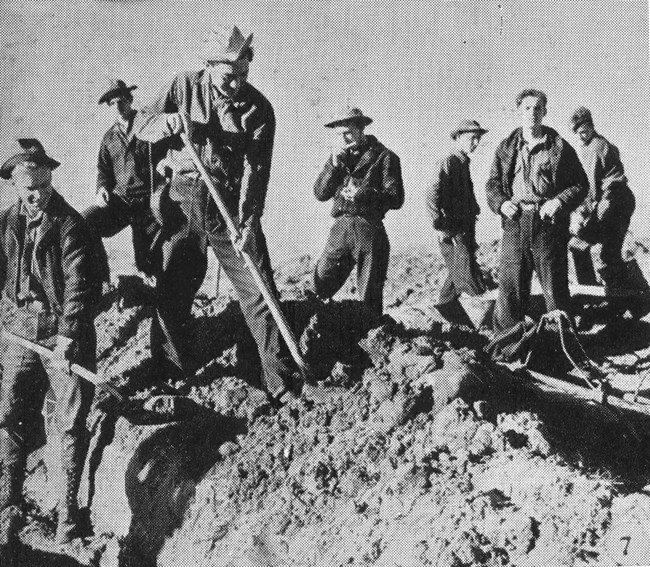
NPS Photo
The so-called "Tree Troopers" of the CCC worked to preserve forests, prevent soil erosion, build roads, and create recreational areas like campgrounds and hiking trails. CCC enrollees were typically unmarried young men between the ages of 18 and 25, who enrolled for a period of 6 months to two years. Enrollees came from families that had been hit hard by the Depression, and were often grateful for the opportunity to work, and receive regular meals and housing. Only men were allowed to enroll, and the camps where they served were segregated by race.
The Pacific Northwest district of the CCC was located in the U.S. Army's Ninth Corps Area. Beginning in 1933, Vancouver Barracks served as its headquarters until the CCC program ended in 1942. New enrollees were trained at the post before being sent to one of the 27 forest camps in the region.
Many enrollees developed ties to the community and chose to stay in Vancouver after being discharged.
President Roosevelt believed that the CCC experience would leave enrollees with a sense of community and citizenship that they would then spread into the communities they entered. In Vancouver and Portland, the integration of CCC enrollees into the community was an important part of life in the 1930s and the public works projects they completed continue to give us places to gather and connect.
"Idle through no fault of your own, you were enrolled from city and rural homes and offered an opportunity to engage in healthful, outdoor work on forest, park and soil conservation projects of definite practical value to all the people of the nation. The promptness with which you seized the opportunity to engage in honest work, the willingness with which you have performed your daily tasks and the fine spirit you have shown in winning the respect of the communities in which your camps have been located, merits the admiration of the entire country.
You, and the men who have guided and supervised your efforts, have cause to be proud of the record the CCC has made in the development of sturdy manhood and in the initiation and prosecution of a conservation program of unprecedented proportions."
- President Franklin D. Roosevelt, in a message read over NBC radio to CCC enrollees, 1936

Gifford Pinchot National Forest
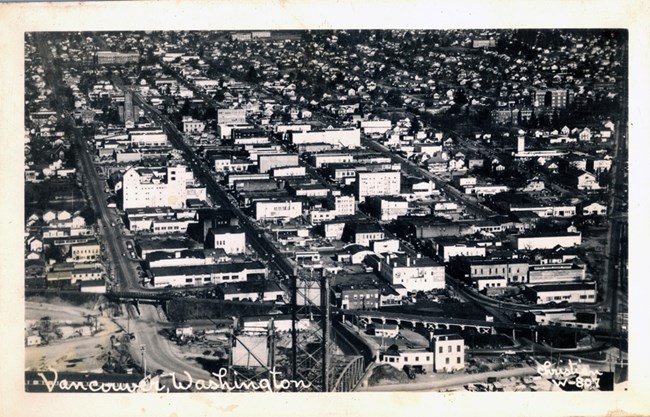
NPS Photo
From Post-War Devastation to Pre-War Preparation
During World War I, things were looking up for the citizens of Vancouver. The city's population boomed, local businesses and agriculture flourished, and the Spruce Mill at Vancouver Barracks provided thousands of feet of lumber every day to build airplanes for the Allied war effort.
In the months after the war ended in 1919, the Spruce Mill closed and Vancouver Barracks transformed into a demobilization center, overseeing the departure of 30,000 men from the army. This demobilization caused surpluses in the market and an agricultural depression.
The economic hardships of Vancouver during the 1920s were magnified when the stock market crashed in 1929 and the Great Depression began. During the Depression, the Northwest experienced a decline in lumber exports, decreases in manufacturing, mortgage foreclosures, and huge increases in homelessness.
The introduction of the CCC at Vancouver Barracks brought about the arrival of thousands of program enrollees, called "Tree Troopers" by the community because of their forestry work. The introduction of these men to the local community, where the enrollees sometimes spent their free time, helped the area to recover by providing new customers for local businesses.
To stimulate the depressed economy, CCC workers were required to send their families $25 of their $30 per month wage. On weekends, enrollees were given time off to spend their remaining earnings at local movie theaters, dancehalls and roller-skating arenas. Some of the places frequented by CCC men, like Vancouver's Kiggins Theater and the Crystal Ballroom in Portland, still exist today.
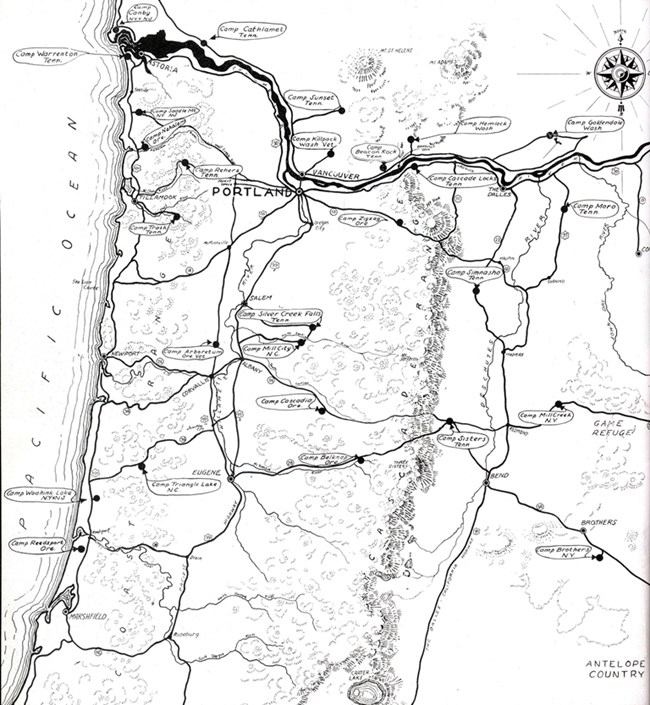
NPS Photo
The CCC at Vancouver Barracks
Men from the Pacific Northwest and beyond came to Vancouver Barracks when they first enrolled in the CCC. For two to three days, they lived in barracks built by the army for new enrollees. After passing a physical examination, the men received recycled World War I-era supplies, including three sets of clothing, two pairs of shoes, a hat, a belt, a raincoat, and other personal items. After receiving supplies and training at the barracks, CCC enrollees were deployed to camps throughout the region.
The CCC program at Vancouver Barracks brought about an infrastructure overhaul at the site that was funded by the Works Progress Administration and coordinated by General George C. Marshall, the post's commanding officer. Between 1936 and 1938, General Marshall created lasting partnerships between the City of Vancouver, Clark County, and the U.S. Army, and he initiated a $400,000 allocation of WPA funds for the preservation of Vancouver Barracks.

Gifford Pinchot National Forest
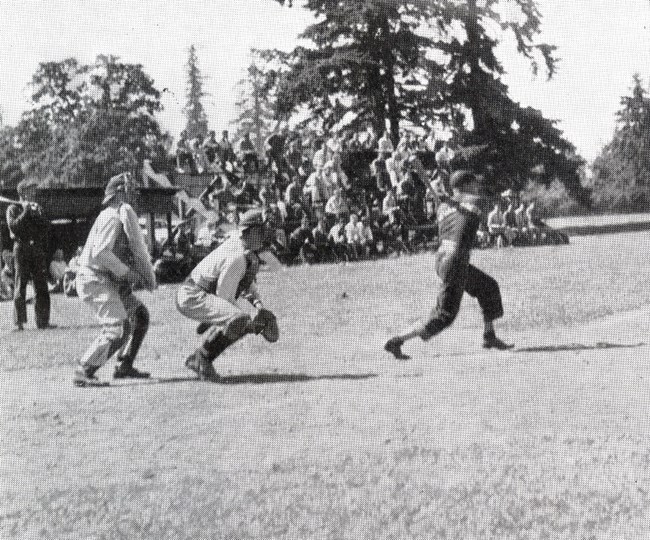
NPS Photo
Community Among the "Tree Troopers"
The goal of the CCC was not just to undertake forestry projects, but also to foster a sense of community and civics in a generation of young, unemployed men. To do this, the CCC offered a variety of activities and programs.
Many enrollees participated in organized sports, including basketball, volleyball, baseball, and boxing. To develop their work and life skills, vocational and academic classes, religious practice, cooking classes, and arts programs were also offered.
As regional headquarters, Vancouver Barracks was responsible for hosting the annual Ninth Area Corps Olympics, where enrollees came together to show off their athletic skills and meet enrollees from neighboring camps. It was also common for camps to write and produce their own newspapers that were distributed regionally. At Vancouver Barracks, General Marshall created a newspaper for CCC enrollees called "The Review."
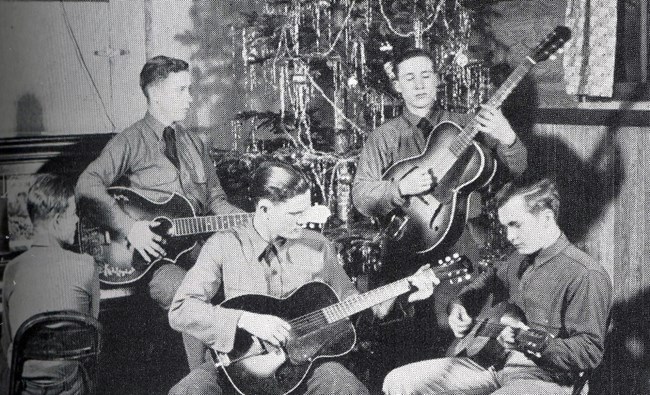
NPS Photo
"Tree Troopers" and the Local Community
Because of their dedication to public service and excellent reputation, CCC enrollees were admired by residents of Vancouver and in towns near CCC camps in the Northwest, and CCC enrollees were often invited into local homes for meals. It was also common for enrollees to perform musical concerts or participate in sporting events at neighboring high school auditoriums.
Though many CCC enrollees came to Vancouver from cities around the country, the CCC also employed more skilled or educated members of the local community to serve as leaders for special projects.
Many enrollees met their wives and closest friends during their time with the CCC in the Northwest. The ties formed between the CCC men and local communities often allowed enrollees to find local jobs after they were discharged from duty.

NPS Photo
Cultural Legacies and Community Benefits
By the time they were discharged from the CCC, enrollees had gained skills that allowed them to establish themselves as workers and leaders. The men who participated in the Ninth Army Corps area were given an even greater opportunity to build their skills and boost morale in one of our nation's most desperate times.
After leaving the program, enrollees took on a wide variety of careers, often using the job skills they had acquired in the CCC. After the United States entered World War II, many former enrollees enlisted in the military, and reported feeling more prepared for military service because of their CCC experience.
The work done by the CCC also encouraged the idea of environmental conservation and sustainability, and was, in a way, an extension of the ideas set forth by the agencies with whom they worked closely: the National Park Service and the U.S. Forest Service. After leaving the program, some former enrollees took jobs with these agencies.
Among hundreds of projects initiated by the CCC, the program was responsible for building the Bonneville Dam, much of the infrastructure at Beacon Rock State Park, campgrounds and trails on the Columbia River gorge, and Timberline Lodge on Mt. Hood. At Fort Vancouver National Historic Site, a handful of buildings built during the CCC period remain today.
CCC Projects in the Pacific Northwest
- Beacon Rock State Park
- Eagle Creek Trail and Campground
- Bonneville Dam
- Trout Creek Dam
- Gold Butte Lookout, Willamette National Forest
- Rocky Butte Scenic Drive, Portland, Oregon
- Sunset Highway, Portland, Oregon
- Westmoreland Park, Portland, Oregon
- Rainbow Falls State Park, Lewis, Washington
- Zig Zag Camp
- Forest fire prevention
- Highway construction
- Telephone pole construction
- Timberline Lodge
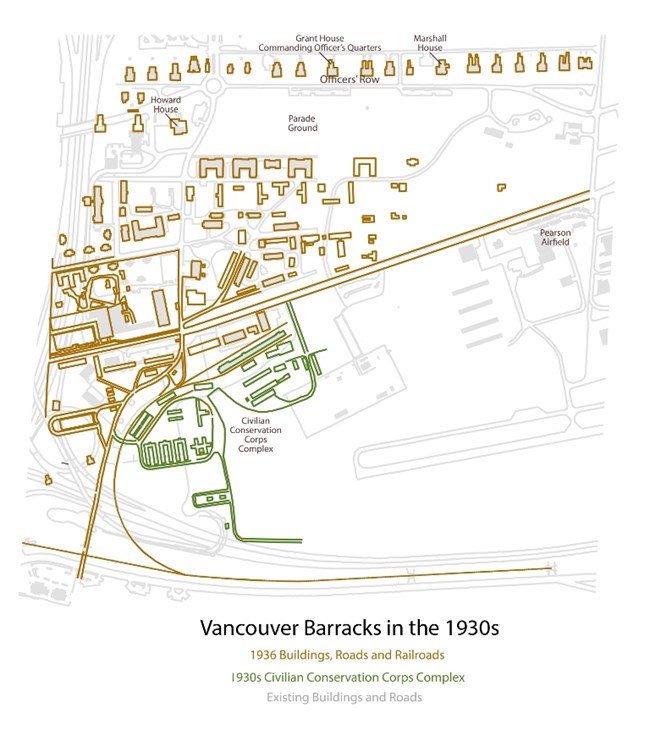
Archaeological Remains of the CCC at Vancouver Barracks
At Fort Vancouver National Historic Site, archaeologists continue to do archaeological surveys in the areas where CCC enrollees lived and worked. Through excavations and archival research, we are learning new information about how the "tree troopers" lived and interacted with the civilian and military communities in Vancouver.
Most of the buildings built at Vancouver for the CCC were located in the southern portion of the barracks, where you see the "Civilian Conservation Corps" outlined in green on this map. The three U-shaped buildings in the lower left of this complex served as housing for CCC enrollees. Because they were not meant to be permanent, many of these buildings have since been demolished.
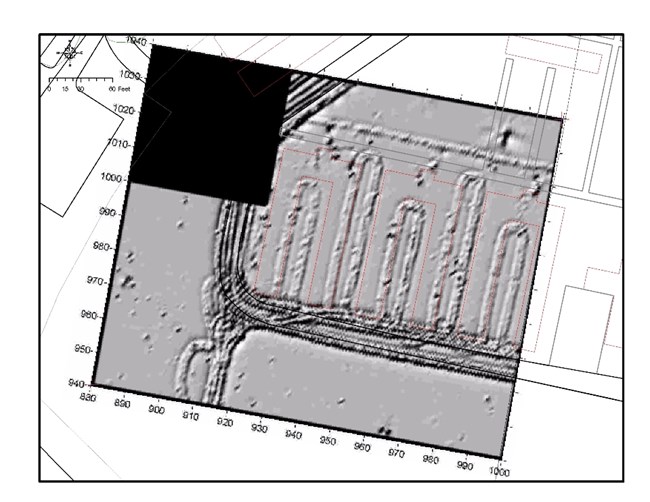
NPS Photo
The CCC Underground
Artifacts from the CCC's time at Vancouver Barracks are not plentiful. However, other remnants of this period can be found underground. In 2003, archaeologist Kendal McDonald, under the direction of National Park Service Archaeologist Dr. Bob Cromwell, conducted a magnetic survey using a Geometrics G-858 cesium magnetometer in the area where the CCC barracks once stood, to the west of the reconstructed Fort Vancouver.
This device measures the magnetic strength of underground features, including artifacts and the remains of buildings. Maps created from this survey, including the map to the left, show that the remains of roads constructed during the CCC period still exist. The foundation of the U-shaped CCC barracks, where enrollees lived, can also be seen.
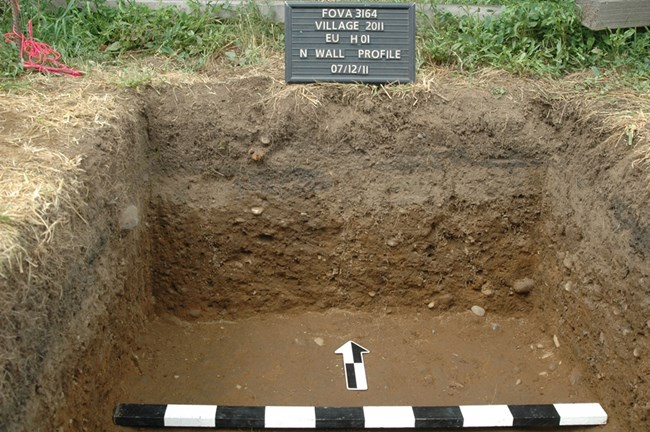
NPS Photo
In this photograph, taken during the 2011 Public Archaeology Field School, you can see the remains of the asphalt CCC road a few inches below the surface, and above the dark brown section of dirt. This dark grey stripe can be seen on all sides of the excavation unit.
